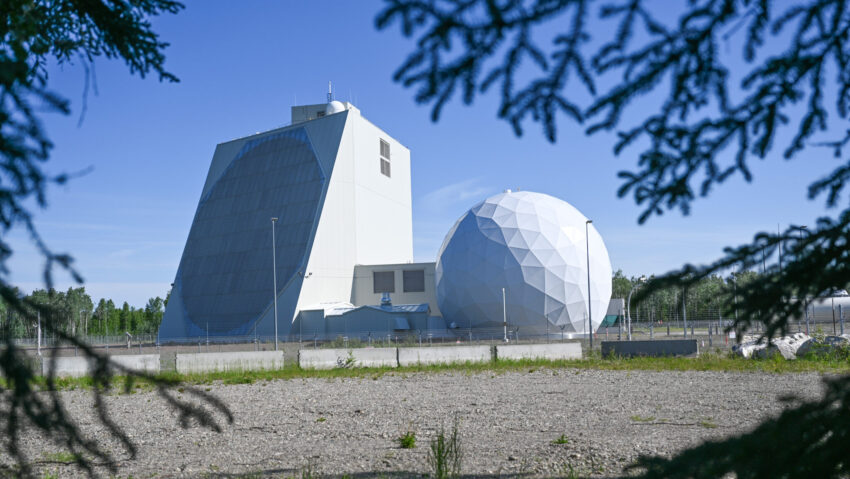The long-range ballistic missile surveillance radar building, part of the Solid State Phased Array Radar Systems, at the 213th Space Warning Squadron, Clear Space Force Station, Alaska, on June 21, 2024. (US Air National Guard photo by Senior Airman Colin Simpson)
WASHINGTON — Moving away from reliance on large, ground-based radars in favor of a networked layer of smaller passive sensors could “substantially improve” US air and missile defenses and decrease vulnerability to attack, argues a new study by the Center for Strategic and International Studies (CSIS).
“Faced with the threat of complex and integrated attack, the existing air and missile defense architecture would benefit from a more proliferated, passive, and ultimately resilient posture. Doing so would, at long last, better align AMD [air and missile defense] operations to the strategic environment of today,” the
CSIS authors assert.
Called “Mesh Sensing for Air and Missile Defense,” the study is a highly technical look at how such a network of multiple passive sensors could be designed and implemented, as well as the advantages and disadvantages.
The study posits a notional network to provide coverage of Poland as an example, finding that such a network if developed would require 400 electro-optical and infrared sensors, linked together by a robust communications and power grid.
According to the study, Poland was used as a case study because its geography “offers a useful test case for considering meshed sensors, with a mix of relevant topographies and an area comparable to theaters of interest, including in the Indo-Pacific.”
Most of the US military’s current air and missile defense systems rely on a small number of high-powered radars, which pinpoint targets by blasting out and then receiving the reflections of electromagnetic waves. Radars have many advantages, including day and night all-weather capability and long ranges. Their radiating energy, however, in turn is increasingly easy for adversary weapon systems to detect. And the longer a radar’s range, the more power it needs and the more energy it emits.
By contracts, passive systems — such as electro-optical, infrared, acoustic and specialized radiofrequency sensors — do not need to emit energy to find and fix targets, as they simply collect the energy emanating from those incoming weapon systems. Thus, they are harder for adversaries to find, track and target.
Examples of such systems, according to the study, include Ukraine’s “Sky Fortress” network that relies on acoustic sensors that listen for sound energy, using microphones that “do not emit easily detectable signals.” The US Army also uses passive radio receivers for its Army Long-Range Persistent Surveillance (ALPS) system, which already is deployed in various theaters, CSIS notes.
That said, passive systems also face obstacles, with degradation by clouds and bad weather being a primary problem. Thus, the CSIS study concludes that the optimal architecture for a comprehensive AMD sensor network would be hybrid, using multiple system types.
“The challenges posed by weather underscore the need to integrate meshed sensors with other passive sensing modalities and existing, active architectures. Passive, multistatic radar, passive radiofrequency detection, acoustic systems, and other approaches all stand to play potential roles,” the study says.
The study acknowledges that even a mixed system could have its blind spots. One is that because ground-based sensors of all sorts “face limits to their ability to track low-flying airborne targets. Both Earth’s curvature and surrounding terrain features block ground-based sensors’ line of sight at lower viewing angles, limiting maximum range. This is why deployments at higher elevations are often preferable,” it explains. (Indeed, this is a key reason why satellites traditionally have been used to detect and track ballistic missile launches around the globe.)
The study stresses that the placement of various sensors in such a hybrid system isn’t as simple as scattering them on hills and mountains.
“The challenge, however, comes with planning meshed laydowns. … Site selection for even an individual radar is an involved process in which potential missile launch sites, tactical mobility, and other considerations are accounted for. With more sensors involved, these problems balloon in complexity. … Computational approaches are needed to determine where to place proliferated sensors,” the study says.
Another problem for a proliferated AMD sensor architecture is ensuring access to power grids and robust communications networks, the study finds.
“At an operational level, realizing proliferated sensor networks will require the services to further integrate existing analytic tools for mobility planning with air and missile defense mission planning. Sensors connected to centralized power supplies could open civilian power grids to enemy attack, demanding distributed grids with high-performance battery, solar, generator, or fuel cell supplies,” the study stresses. “Additionally, the physical communications backbone that connects gridded assets will need engineering and placement as careful as that required by the sensors themselves.”
In sum, while the CSIS case study for a hypothetical Polish system found both improved performance and greater resilience from use of a mesh network of proliferated passive sensors, it also makes clear that development of such such multi-node architectures will not be easy (or, via inference, cheap).
“Much remains to be done to bring this philosophy to earth,” the study concludes.
Click this link for the original source of this article.
Author: Theresa Hitchens
This content is courtesy of, and owned and copyrighted by, https://breakingdefense.com and its author. This content is made available by use of the public RSS feed offered by the host site and is used for educational purposes only. If you are the author or represent the host site and would like this content removed now and in the future, please contact USSANews.com using the email address in the Contact page found in the website menu.








